Trip to western Mali – Day 3
Today was reserved for driving through the entire study area and getting a feel for the different habitats represented and seeing where the various infrastructure are planned. We started in the south, arriving at a large grassy plain surrounded by closed woodland and thickets. The change in scenery was quite dramatic and gave us an indication of how heterogenous the area is.  The reason for the lack of trees and shrubs is because the laterite is almost unweathered and presents as sheetrock in many places, giving no place for trees to send down roots. This rock layer just below the surface also results in temporary flooding during the wet season and extreme drought during the dry season, making it a hostile environment foAs to be expected, the birds present on the open plains were quite different to the surrounding woodlands. These included Sun Lark, Wattled Lapwing, Forbes’ Plover, small groups of Red-throated Bee-eaters, and mixed flocks of Red-throated and Pied-winged Swallows. A small troop of attractive Patas Monkeys ran off into the woodlands at our arrival. One of the highlights in this area was a small temporary pan that was covered with a mass of aquatic plants, including the sky-blue Monochoria brevipetiolata, an unidentified Dopatrium species and the clover-leaf fern Marsilea cf. polycarpa.
The reason for the lack of trees and shrubs is because the laterite is almost unweathered and presents as sheetrock in many places, giving no place for trees to send down roots. This rock layer just below the surface also results in temporary flooding during the wet season and extreme drought during the dry season, making it a hostile environment foAs to be expected, the birds present on the open plains were quite different to the surrounding woodlands. These included Sun Lark, Wattled Lapwing, Forbes’ Plover, small groups of Red-throated Bee-eaters, and mixed flocks of Red-throated and Pied-winged Swallows. A small troop of attractive Patas Monkeys ran off into the woodlands at our arrival. One of the highlights in this area was a small temporary pan that was covered with a mass of aquatic plants, including the sky-blue Monochoria brevipetiolata, an unidentified Dopatrium species and the clover-leaf fern Marsilea cf. polycarpa.  A short walk into the surrounding woodlands produced a birding highlight in the form of a pair of Adamawa Turtle Doves that perched in full view for a few minutes. This very localised species was unknown from Mali until recently, and I was really hoping to find it! We then continued to a track that followed the Faleme River to the eastern boundary of the tenement area, where I encountered my first Khaya senegalensis trees, and other typical riparian forest species such as Uvaria chamae and Spondias mombin. We then drove through the centre of the tenement area, across laterite plains that had scattered Impala Lilies, to a ridge along the eastern boundary from where we could look down onto a large portion of the survey area.
A short walk into the surrounding woodlands produced a birding highlight in the form of a pair of Adamawa Turtle Doves that perched in full view for a few minutes. This very localised species was unknown from Mali until recently, and I was really hoping to find it! We then continued to a track that followed the Faleme River to the eastern boundary of the tenement area, where I encountered my first Khaya senegalensis trees, and other typical riparian forest species such as Uvaria chamae and Spondias mombin. We then drove through the centre of the tenement area, across laterite plains that had scattered Impala Lilies, to a ridge along the eastern boundary from where we could look down onto a large portion of the survey area.
Trip to western Mali – Days 1-2
Duncan McKenzie and I met up with Fanie Coetzee and the rest of the Epoch team at O.R. Tambo International Airport on evening of Sunday 12 August 2012. Our flight to Dakar took approximately 9 hours, but included a time zone shift backwards. So we arrived in Dakar at the awkward time of 00h45! Fortunately the Hotel Onomor is 5 minutes from the airport, and it was not long before we were checked into our rooms and trying to get some sleep (especially those of us who do not sleep in the unnatural upright position of an airplane seat!).
After an early breakfast at the hotel we checked out and were shuttled across to the airport for our charter flight. This departed on time and we enjoyed a pleasant 2-hour journey across to eastern Senegal. 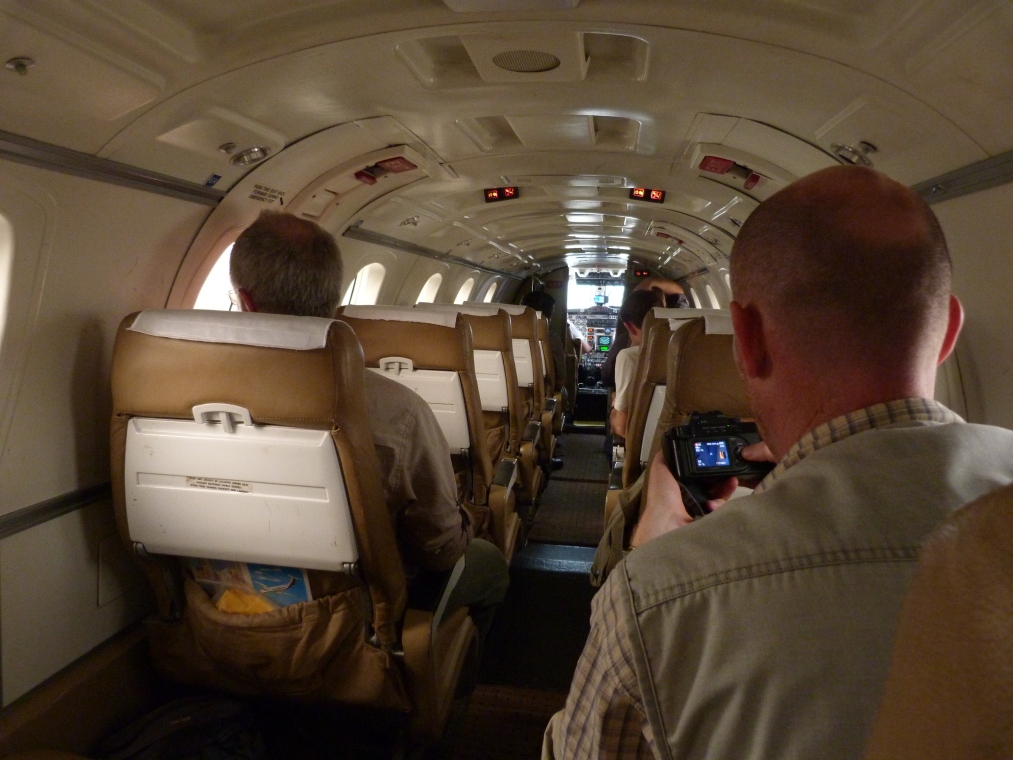 We landed at the small strip outside of Kedougou, where we were met by our driver and Papillon representative. However, the end of the journey was still a long way off and we began a four hour drive through eastern Senegal to the Mali border. The border crossing was very short of formalities and did not even involve stamping of passports on the Mali side (a BIT disconcerting). We then drove to the dirty small town of Kenieba where we transferred from the minibus to two four-wheel drive Toyotas. This was the start of the journey by dirt road south to the exploration camp at Fedougou. About halfway to Fedougou we encountered an impassable river and were ferried across in dugout canoes to another set orf vehicles waiting for us on the other side! What a mission!
We landed at the small strip outside of Kedougou, where we were met by our driver and Papillon representative. However, the end of the journey was still a long way off and we began a four hour drive through eastern Senegal to the Mali border. The border crossing was very short of formalities and did not even involve stamping of passports on the Mali side (a BIT disconcerting). We then drove to the dirty small town of Kenieba where we transferred from the minibus to two four-wheel drive Toyotas. This was the start of the journey by dirt road south to the exploration camp at Fedougou. About halfway to Fedougou we encountered an impassable river and were ferried across in dugout canoes to another set orf vehicles waiting for us on the other side! What a mission! 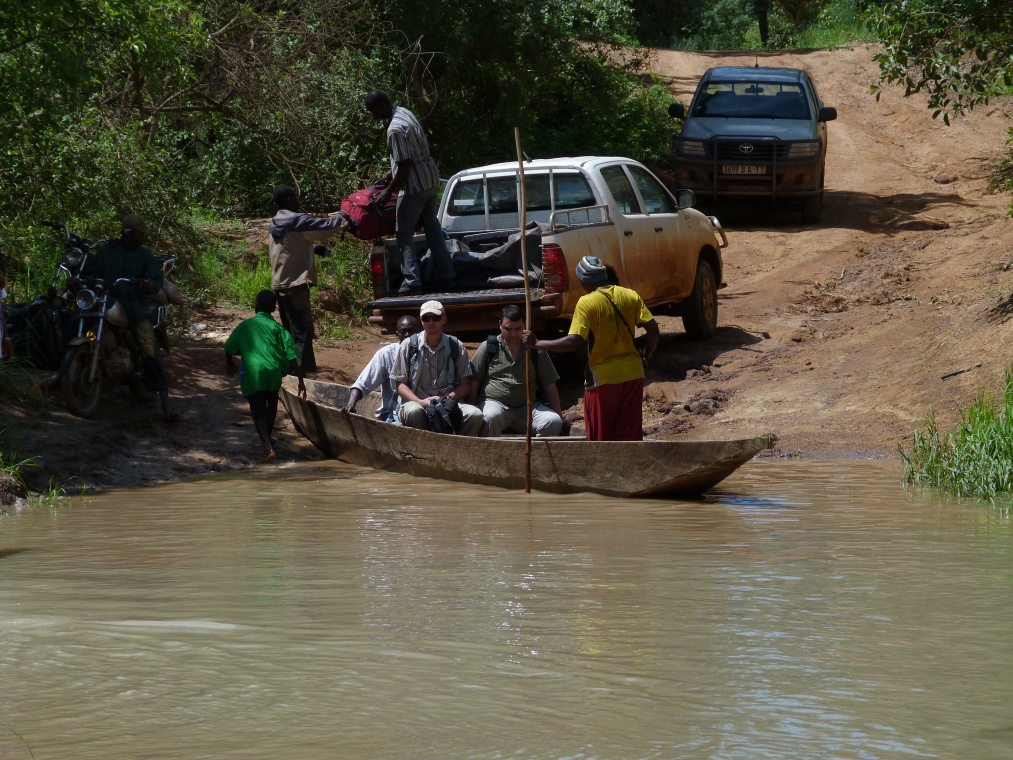 The potentially eventful crossing was without incident and we proceded south to camp, arriving in the late afternoon. The camp is situated in tall riparian woodland dominated by Spondias mombin and Pterocarpus erinaceus trees, with constant bird activity through the day. Some good birds seen in camp while we transferred our luggage and settled in were African Blue Flycatcher, Long-tailed Starling and a small flock of Senegal Parrots. Duncan, Fanie, Alan and myself headed out on a short walk through the riparian vegetation close to camp in the late afternoon. Bird activity was surprisingly high, particularly small flocks of seed-eaters. Some of the highlights included Red-cheeked Cordonbleu, Lavender Waxbill, a striking male Black-bellied Firefinch, Black-capped Babblers, the brightly-coloured Yellow-crowned Gonolek, noisy Broad-billed Rollers and a delicate African Pygmy Kingfisher. Returned to camp just before dark, feeling very satisfied with my first taste of Mali birding.
The potentially eventful crossing was without incident and we proceded south to camp, arriving in the late afternoon. The camp is situated in tall riparian woodland dominated by Spondias mombin and Pterocarpus erinaceus trees, with constant bird activity through the day. Some good birds seen in camp while we transferred our luggage and settled in were African Blue Flycatcher, Long-tailed Starling and a small flock of Senegal Parrots. Duncan, Fanie, Alan and myself headed out on a short walk through the riparian vegetation close to camp in the late afternoon. Bird activity was surprisingly high, particularly small flocks of seed-eaters. Some of the highlights included Red-cheeked Cordonbleu, Lavender Waxbill, a striking male Black-bellied Firefinch, Black-capped Babblers, the brightly-coloured Yellow-crowned Gonolek, noisy Broad-billed Rollers and a delicate African Pygmy Kingfisher. Returned to camp just before dark, feeling very satisfied with my first taste of Mali birding.
Trip to the Republic of Guinea – Day Four
Took a pre-breakfast walk down to the mangroves at the mouth of the river. Overcast and windy conditions meant that not many birds were to be seen. Red-chested Swallows were regularly seen overhead, and both Green-backed Heron and Pied Kingfisher were present in the mangroves. All three of the common mangrove trees were in flower, namely Rhizophora mangle, Avicennia germinans and Laguncularia racemosa, giving me a good opportunity to get aquainted with them. 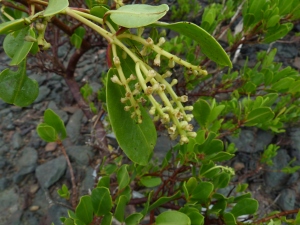 A basic breakfast at the hotel was followed by a drive back up the road to the AluFer camp, where we met up with the Okapi team. The plan was to visit key sites in the project area and get a feel for the issues that need to be dealt with. We started at Kalikali, the northernmost hill in the tenement. The site is characterised by open grassland on laterite, surrounded by closed woodland which is characterised by trees such as Parkia biglobosa, Pterocarpus erinaceus and Lannea species.
A basic breakfast at the hotel was followed by a drive back up the road to the AluFer camp, where we met up with the Okapi team. The plan was to visit key sites in the project area and get a feel for the issues that need to be dealt with. We started at Kalikali, the northernmost hill in the tenement. The site is characterised by open grassland on laterite, surrounded by closed woodland which is characterised by trees such as Parkia biglobosa, Pterocarpus erinaceus and Lannea species. 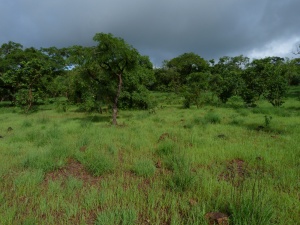 A small non-perennial stream runs through the centre of the grassland and feeds a small patch of gallery forest. From there we moved to another one of the hills in the centre of the project area, and then it was on to Cape Verga at the coast. This rocky promontory is covered with treacherously slippery green algae and we needed to take care walking across the rocks. A small grove of Rhizophora mangrove trees has established on the rocks, and another mangrove species, Conocarpus erectus, was found.
A small non-perennial stream runs through the centre of the grassland and feeds a small patch of gallery forest. From there we moved to another one of the hills in the centre of the project area, and then it was on to Cape Verga at the coast. This rocky promontory is covered with treacherously slippery green algae and we needed to take care walking across the rocks. A small grove of Rhizophora mangrove trees has established on the rocks, and another mangrove species, Conocarpus erectus, was found.  We then drove back to the AluFer camp for a late lunch, after which we decided to try and find one of the sacred forests in order to get an idea of the biodiversity value of these relic forests.
We then drove back to the AluFer camp for a late lunch, after which we decided to try and find one of the sacred forests in order to get an idea of the biodiversity value of these relic forests.
We drove to Damouya Sacred Forest, hoping to just get to see the edge of the forest but realising that the chance of being able to enter the forest was unlikely. Imagine our suprise when some of the local community members who were planting rice at the edge of the forest offered to take us in to the forest and show us a cave site! Ecstatic we quickly agreed and followed two of them into the tall forest. A short walk down to the forested stream revealed a small waterfall over a rock ledge and under the ledge was a deep overhang which could ostensibly be called a cave. 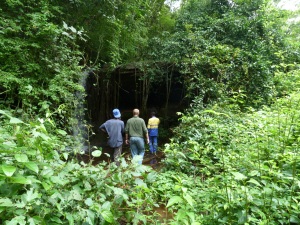 I was hoping to find evidence of nesting Picathartes, a rare and secretive bizarre bird that nests in forested caves, but was unsuccessful. However, the locals said that birds do use this cave, so it could still be possible! We were not allowed much time in the forest and had to leave after a few minutes at the cave. Even that short time was worth it and I was overjoyed – definitely a highlight of this trip. That was it for the day and we headed back to camp.
I was hoping to find evidence of nesting Picathartes, a rare and secretive bizarre bird that nests in forested caves, but was unsuccessful. However, the locals said that birds do use this cave, so it could still be possible! We were not allowed much time in the forest and had to leave after a few minutes at the cave. Even that short time was worth it and I was overjoyed – definitely a highlight of this trip. That was it for the day and we headed back to camp.
Trip to the Republic of Guinea – Day Three
We were back at the airport after an early breakfast this morning. Check-in went smoothly and it wasn’t long before we sitting in the departure lounge once again, hoping for a different result today. And that is what we got. The plane departed according to schedule and in an hour and a half we touched down in a rainy Conakry. Until now everything had run quite smoothly….remember my comment yesterday??? Not understanding French is a huge disadvantage, but we could see that more and more people were getting disgruntled at the news coming through at the baggage collection point. The AluFer staff member that had come to meet us soon informed us that our luggage had not arrived! Senegal Airlines had forgot to load everyone’s luggage. Seems they suffer from an advanced form of incompetence! We had no choice but to head out to our vehicle and drive north to the project area. Another day in the same set of clothing awaited us!
Conakry is situated on a long peninsula which is covered by urban sprawl. Traffic congestion is rife and it was easy to see how the 270 km drive to site could sometimes take up to 6 hours. 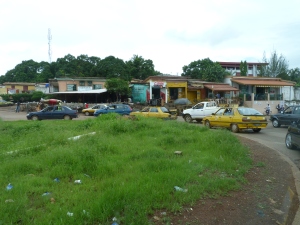 Once we had wrestled ourselves free of Conakry we could pick up speed. We followed the highway along the coastal plain, with beautiful views of the escarpment to the east. It was clear that we were well into the wet season, with many waterfalls flowing off the sheer escarpment cliffs and most rivers in spate. Very few areas of natural habitat remain, with even the upper slopes of the steep escarpment suffering deforestation.
Once we had wrestled ourselves free of Conakry we could pick up speed. We followed the highway along the coastal plain, with beautiful views of the escarpment to the east. It was clear that we were well into the wet season, with many waterfalls flowing off the sheer escarpment cliffs and most rivers in spate. Very few areas of natural habitat remain, with even the upper slopes of the steep escarpment suffering deforestation. 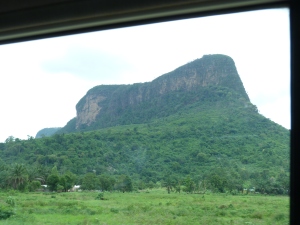 We arrived at the small town of Boffa at midday where we met with the district commissioner and two of his assistants, as well as the Okapi Environmental team. After a short meeting and introductions we continued along the coast towards Bel-Air, with two stops within the project area to orientate us. We stopped for a brief afternoon meal at the AluFer camp, after which we continued to the Bel-Air Hotel.
We arrived at the small town of Boffa at midday where we met with the district commissioner and two of his assistants, as well as the Okapi Environmental team. After a short meeting and introductions we continued along the coast towards Bel-Air, with two stops within the project area to orientate us. We stopped for a brief afternoon meal at the AluFer camp, after which we continued to the Bel-Air Hotel.
Trip to the Republic of Guinea – Day Two
The morning was spent at the Terrou-Bi Hotel, situated on a small private beach along the Senegal coastline and overlooking the Iles des Madeleines. 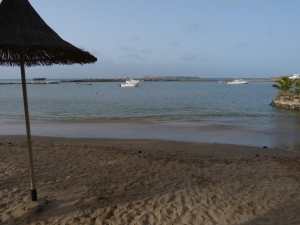 A morning walk along the coastline did not produce much apart from a few White-breasted Cormorants perched on boats in the small harbour, a pair of Spur-winged Lapwings in the hotel grounds, several Common Bulbuls in the garden and two Western Reef Herons along the rocks.
A morning walk along the coastline did not produce much apart from a few White-breasted Cormorants perched on boats in the small harbour, a pair of Spur-winged Lapwings in the hotel grounds, several Common Bulbuls in the garden and two Western Reef Herons along the rocks.  The team met each other properly after breakfast and then we had time to do a bit of work until checkout time. From there it was back to the airport for an evening flight to Conakry (Republic of Guinea). When travelling in West Africa its good to keep in mind that when it seems to be going so smoothly, then something is about to go wrong! We had checked through to the departure lounge and were waiting for our flight when we were told that the weather in Conakry was too bad for us to land. The flight was being postponed to tomorrow morning 10h00!! So we had to get a taxi back to the Terrou-Bi for another night at the hotel. Worse still, our luggage had already been loaded onto the plane, so were without our luggage.
The team met each other properly after breakfast and then we had time to do a bit of work until checkout time. From there it was back to the airport for an evening flight to Conakry (Republic of Guinea). When travelling in West Africa its good to keep in mind that when it seems to be going so smoothly, then something is about to go wrong! We had checked through to the departure lounge and were waiting for our flight when we were told that the weather in Conakry was too bad for us to land. The flight was being postponed to tomorrow morning 10h00!! So we had to get a taxi back to the Terrou-Bi for another night at the hotel. Worse still, our luggage had already been loaded onto the plane, so were without our luggage.
Trip to the Republic of Guinea – Day One
Met up with Fanie Coetzee of Epoch Resources at O.R.Tambo International Airport and headed through to the departure lounge for a coffee. The purpose of this trip is to see the AluFer bauxite mine project at Bel-Air in coastal Guinea and then to review the reports produced to date in the context of what we have seen. The route to Guinea was not a simple one and involved quite a bit of travel. Our plane to Dakar departed at 19h00 as scheduled and I had my first look at the specialist reports that had been compiled late last year in the project area. Even though the flight took 8.5 hours, the change in time zones meant we landed at 01h30 in Dakar, Senegal. Amazingly, even at that crazy time there was still a fair amount of traffic on the road between the airport and our hotel. We checked into the hotel Terrou-Bi at about 02h30 and stumbled to our rooms.
Dry Season Trip to Selous Game Reserve – Day 4
We started the second full field day with a trip to a drainage line about 1 km NNE of camp. The vehicles were parked at the pump station from which water is pumped up to camp, and the team followed the stream (which was mostly dry), for approximately 800 metres. The grassy valley bottom was lined by dense thickets, with species such as Syzygium guineense, Rauvolfia caffra, Keetia venosa and Vernonia colorata being common throughout. 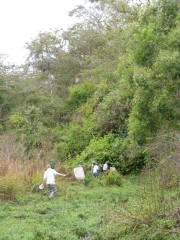 After a few hundred metres we entered a tall swamp forest that was dominated by Syzygium guineense and Shirakiopsis ellipticus, with other prominent trees being Erythrophloeum suaveolens, Rothmannia manganjae (in flower), Voacanga thouarsii and Pachystela brevipes. The swamp forest was a special place, even if it was not flooded at this time of the year. After following the forest trail for about 200 metres we entered another grassy valley bottom which is most likely an impressive wetland during the rain season. Two massive Milicia excelsa trees marked the edge of the wetland. Always a privilege to stand under these giants.
After a few hundred metres we entered a tall swamp forest that was dominated by Syzygium guineense and Shirakiopsis ellipticus, with other prominent trees being Erythrophloeum suaveolens, Rothmannia manganjae (in flower), Voacanga thouarsii and Pachystela brevipes. The swamp forest was a special place, even if it was not flooded at this time of the year. After following the forest trail for about 200 metres we entered another grassy valley bottom which is most likely an impressive wetland during the rain season. Two massive Milicia excelsa trees marked the edge of the wetland. Always a privilege to stand under these giants. 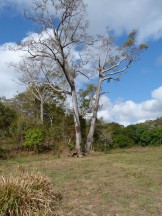 And to add to the pleasure, we were spoilt with great views of a pair of Brown-breasted Barbets perched in the leafless canopy. A cross-section profile of the valley vegetation was done and then we returned to the vehicles for lunch. Thankfully, Duncan spotted a small Uroplectes scorpion in the leaf litter before sitting on it! After lunch we drove back towards camp and then along the spine of a narrow ridge NE of camp and just to the east of the valley we had followed in the morning. The grassland along the ridge had recently burnt, making the floristic survey a bit complicated. However, several trees along the edge of the grassland were in full bloom, most notably Dombeya rotundifolia and Stereospermum kunthianum. Another highlight was a magnificent Leopard Orchid in full bloom in a dead tree.
And to add to the pleasure, we were spoilt with great views of a pair of Brown-breasted Barbets perched in the leafless canopy. A cross-section profile of the valley vegetation was done and then we returned to the vehicles for lunch. Thankfully, Duncan spotted a small Uroplectes scorpion in the leaf litter before sitting on it! After lunch we drove back towards camp and then along the spine of a narrow ridge NE of camp and just to the east of the valley we had followed in the morning. The grassland along the ridge had recently burnt, making the floristic survey a bit complicated. However, several trees along the edge of the grassland were in full bloom, most notably Dombeya rotundifolia and Stereospermum kunthianum. Another highlight was a magnificent Leopard Orchid in full bloom in a dead tree.  That rounded off a decent day in the field and an approaching thunderstorm sent us scurrying back to camp in the late afternoon. As was becoming the pattern, the day was ended with an evening beer on the platform looking west into the wilderness. What a life!
That rounded off a decent day in the field and an approaching thunderstorm sent us scurrying back to camp in the late afternoon. As was becoming the pattern, the day was ended with an evening beer on the platform looking west into the wilderness. What a life!
Dry Season Trip to Selous Game Reserve – Day Three
Our first full day in the field dawned. An excited group of ecologists loaded up in two Toyota Landcruisers and headed along a series of wooded ridges to the northern part of the project area. Within 30 minutes of leaving camp we came across one of the trip highlights…..a pack of African Wild Dogs with pups!! What an astounding start to the trip! The dogs played in the road in front of our vehicle, quite unafraid and in fact quite curious. I must have got about 20 great shots of the dogs before they were spooked by something and headed into the woodland. Does it get better than this??  As we headed north the vegetation changed from tall miombo woodland, i.e. woodland dominated by trees in the genera Brachystegia and Julbernardia, to tall, dense thickets dominated by Pteleopsis myrtifolia and Terminalia sambesiaca. The two vegetation types are very different in structure and plant composition, with very little species overlap. Consequently, the bird communities in each are very different and our arrival in the northern thickets was heralded by exotic bird calls such as Eastern Green Tinkerbird, African Broadbill and Eastern Nicator. We drove down one of the ridges to a northern tributary of the Mkuju River and parked in the forest along the river banks. A remarkable 4-5 hours were spent surveying the flora, birds, invertebrates and wetlands in this area. The first vegetation quadrat confirmed that this was a very interesting thicket type with more affinities with coastal thickets and lowland forest than the miombo woodland that it was embedded in. Some of the interesting species included the climbing Combretum pentagonum, Keetia sansibarica, Craibia zimmermannii and Leptactina platyphylla. One highlight was a massive Milicia excelsa tree that emerged at least 15 metres above the thicket canopy.
As we headed north the vegetation changed from tall miombo woodland, i.e. woodland dominated by trees in the genera Brachystegia and Julbernardia, to tall, dense thickets dominated by Pteleopsis myrtifolia and Terminalia sambesiaca. The two vegetation types are very different in structure and plant composition, with very little species overlap. Consequently, the bird communities in each are very different and our arrival in the northern thickets was heralded by exotic bird calls such as Eastern Green Tinkerbird, African Broadbill and Eastern Nicator. We drove down one of the ridges to a northern tributary of the Mkuju River and parked in the forest along the river banks. A remarkable 4-5 hours were spent surveying the flora, birds, invertebrates and wetlands in this area. The first vegetation quadrat confirmed that this was a very interesting thicket type with more affinities with coastal thickets and lowland forest than the miombo woodland that it was embedded in. Some of the interesting species included the climbing Combretum pentagonum, Keetia sansibarica, Craibia zimmermannii and Leptactina platyphylla. One highlight was a massive Milicia excelsa tree that emerged at least 15 metres above the thicket canopy. 
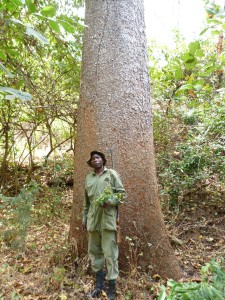 Evidence of regular Elephant traffic and some Buffalo spoor kept us as alert as possible, although we were accompanied by Wildlife Department guards whose senses were far more finely tuned than ours! A late lunch was eaten in the shade of the tall riparian thicket trees. An hour was then spent across the stream in similar thickets, part of which was trying to track down an elusive but very vocal Eastern Green Tinkerbird, to no avail! Our driver was then instructed to drive to a river crossing downstream where he would wait for us. We then set off along the stream bed on foot, spending some of the time crossing grassy wetlands and the rest in the thickets above the banks. A sinister buffalo skull was a reminder of what we needed to be alert for.
Evidence of regular Elephant traffic and some Buffalo spoor kept us as alert as possible, although we were accompanied by Wildlife Department guards whose senses were far more finely tuned than ours! A late lunch was eaten in the shade of the tall riparian thicket trees. An hour was then spent across the stream in similar thickets, part of which was trying to track down an elusive but very vocal Eastern Green Tinkerbird, to no avail! Our driver was then instructed to drive to a river crossing downstream where he would wait for us. We then set off along the stream bed on foot, spending some of the time crossing grassy wetlands and the rest in the thickets above the banks. A sinister buffalo skull was a reminder of what we needed to be alert for.  We arrived at the stream crossing as the sun was dipping towards the horizon and met up with the invertebrate survey team. It was the end of a very productive day and time to head back to camp to enjoy a cold drink on the viewing platform.
We arrived at the stream crossing as the sun was dipping towards the horizon and met up with the invertebrate survey team. It was the end of a very productive day and time to head back to camp to enjoy a cold drink on the viewing platform.
Dry Season Trip to Selous Game Reserve – Day Two
An early start saw us driving along remarkably quiet roads through Dar-es-Salaam…quite a contrast from last night! We arrived on time at Terminal 2 and checked in with the charter flight company that would be flying us to Likuyu. After a short wait in the departure hall we walked across the tarmac to our aircraft and boarded. Excitement was tangible. For everyone except myself, this was the first visit to the Selous, and I did not get to see that much in August anyway. This was going to be a trip of a lifetime. 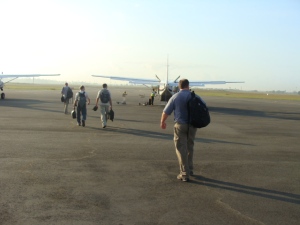 The charter flight from Dar to Likuyu crosses the length of the Selous from north-east to south-west and gives the viewer some perspective of the vast wilderness and astounding variety of habitats present. We touched down at Likuyu at about 09h30, pleased to see that our vehicles were waiting. The drive through the forest reserve adjacent to the Selous was a pleasant one, especially since much of the road had been graded since my last visit. A recent burn had stimulated the small suffrutex Cryptosepalum maraviense to initiate flowering and some parts of the woodland in the first part of the drive were covered in pale lilac blossoms in among the dry leaf litter. Unfortunately, we couldn’t stop for a photograph. We arrived at Mkuju Camp just before lunch and settled in.
The charter flight from Dar to Likuyu crosses the length of the Selous from north-east to south-west and gives the viewer some perspective of the vast wilderness and astounding variety of habitats present. We touched down at Likuyu at about 09h30, pleased to see that our vehicles were waiting. The drive through the forest reserve adjacent to the Selous was a pleasant one, especially since much of the road had been graded since my last visit. A recent burn had stimulated the small suffrutex Cryptosepalum maraviense to initiate flowering and some parts of the woodland in the first part of the drive were covered in pale lilac blossoms in among the dry leaf litter. Unfortunately, we couldn’t stop for a photograph. We arrived at Mkuju Camp just before lunch and settled in. 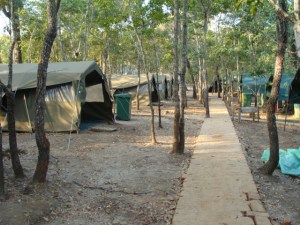 The camp is really well organised and we could see that this was going to set the bar for trips elsewhere in Africa! After lunch we endured the obligatory induction and then spread our maps out on the viewing platform to plan the week’s fieldwork.
The camp is really well organised and we could see that this was going to set the bar for trips elsewhere in Africa! After lunch we endured the obligatory induction and then spread our maps out on the viewing platform to plan the week’s fieldwork. 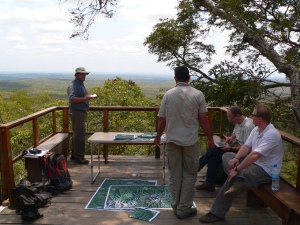 An afternoon drive into the northern part of the project area provided a decent introduction to some of the habitats that we would be working in. A highlight of this drive was the little orchid Polystachya dendrobiflora, which is usually an epiphyte on tall woodland trees, but here in the Selous it grows as a self-supporting species on eroded uranium-enriched crests.
An afternoon drive into the northern part of the project area provided a decent introduction to some of the habitats that we would be working in. A highlight of this drive was the little orchid Polystachya dendrobiflora, which is usually an epiphyte on tall woodland trees, but here in the Selous it grows as a self-supporting species on eroded uranium-enriched crests. 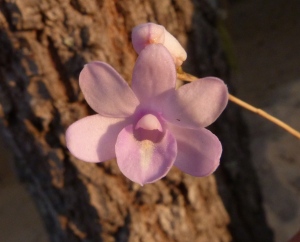
Dry Season Trip to Selous Game Reserve – Day One
The trip we had been waiting for has finally arrived! The start of the biodiversity baseline survey of the Mkuju Uranium Mine project area in Selous Game Reserve, south-central Tanzania. The Biodiversity Survey Team, comprising myself (flora, vertebrate fauna), Duncan McKenzie (vertebrate fauna), Peter Hawkes and Jonathan Fisher (invertebrates), met up with Alan Cochrane from Epoch Resources and Doug McCullough (wetland specialist) at O.R. Thambo International Airport. A mix-up with Doug meant we were seriously running late and we just managed to make the flight to Dar-es-Salaam. We arrived after dark and we treated to our first experience (for some) of the noisy, insane chaos that is Dar traffic. The drive to our hotel was a blur of lights, noise and strange smells. Cold beers were followed by a hearty meal, leaving us ready for a good night sleep.